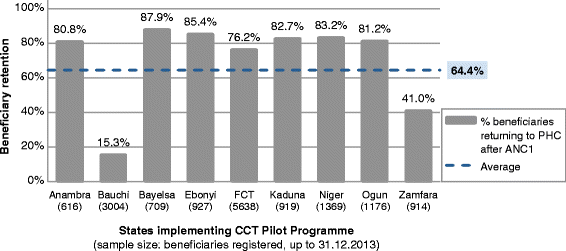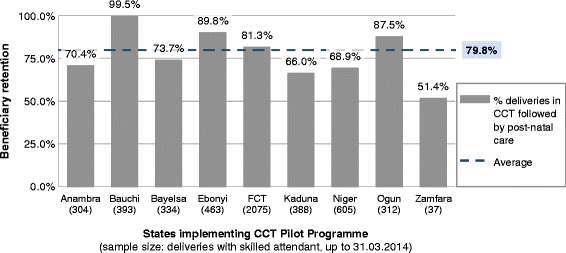Conditional cash transfer schemes in Nigeria: potential gains for maternal and child health service uptake in a national pilot programme
- PMID: 25495258
- PMCID: PMC4273319
- DOI: 10.1186/s12884-014-0408-9
Conditional cash transfer schemes in Nigeria: potential gains for maternal and child health service uptake in a national pilot programme
Abstract
Background: This paper describes use of a Conditional Cash Transfer (CCT) programme to encourage use of critical MNCH services among rural women in Nigeria.
Methods: The CCT programme was first implemented as a pilot in 37 primary health care facilities (PHCs), in nine Nigerian states. The programme entitles women using these facilities up to N5,000 (approximately US$30) if they attend antenatal care (ANC), skilled delivery, and postnatal care. There are 88 other PHCs from these nine states included in this study, which implemented a standard package of supply upgrades without the CCT. Data on monthly service uptake throughout the continuum of care was collected at 124 facilities during quarterly monitoring visits. An interrupted time series using segmented linear regression was applied to estimate separately the effects of the CCT programme and supply package on service uptake.
Results: From April 2013-March 2014, 20,133 women enrolled in the CCT. Sixty-four percent of beneficiaries returned at least once after registration, and 80% of women delivering with skilled attendance returned after delivery. The CCT intervention is associated with a statistically significant increase in the monthly number of women attending four or more ANC visits (increase of 15.12 visits per 100,000 catchment population, p < 0.01; 95% confidence interval 7.38 to 22.85), despite a negative level effect immediately after the intervention began (-45.53/100,000 catchment population; p < 0.05; 95% CI -82.71 to -8.36). A statistically significant increase was also observed in the monthly number of women receiving two or more Tetanus toxoid doses during pregnancy (21.65/100,000 catchment population; p < 0.01; 95% CI 9.23 to 34.08). Changes for other outcomes with the CCT intervention (number of women attending first ANC visit; number of deliveries with skilled attendance; number of neonates receiving OPV at birth) were not found to be statistically significant.
Conclusions: The results show that the CCT intervention is capable of significant effects on service uptake, although results for several outcomes of interest were inconclusive. Key lessons learnt from the pilot phase of implementation include a need to track beneficiary retention throughout the continuum of care as closely as possible, and avert loss to follow-up.
Figures





References
-
- National Population Commission [Nigeria], ICF International . Nigeria Demographic and Health Survey 2013. Abuja, Nigeria and Rockville, Maryland, USA: NPC and ICF International; 2014.
-
- World Bank . World Development Indicators 2014. Washington, DC: World Bank; 2014.
-
- WHO . Trends in Maternal Mortality: 1990 to 2013 - WHO, UNICEF, UNFPA and The World Bank Estimates. Geneva: World Health Organization; 2014.
-
- Country Profile: Nigeria [http://www.countdown2015mnch.org/country-profiles/nigeria]
-
- Williams A. The Evolution of Programs Designed to Increase Utilization of Skilled Birth Attendance in Nigeria. In: World Bank, editor. Science of Delivery Case Study. Washington DC: World Bank; 2014.
Publication types
MeSH terms
LinkOut - more resources
Full Text Sources
Other Literature Sources
Medical
Miscellaneous

